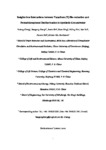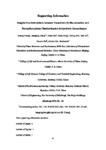Insights into interactions between vanadium (V) bio-reduction and pentachlorophenol dechlorination in synthetic groundwater
| dc.contributor.author | Zhang, Baogang | |
| dc.contributor.author | Cheng, Y | |
| dc.contributor.author | Shi, J | |
| dc.contributor.author | Xing, X | |
| dc.contributor.author | Zhu, Y | |
| dc.contributor.author | Xu, Nan | |
| dc.contributor.author | Xia, J | |
| dc.contributor.author | Borthwick, Alistair | |
| dc.date.accessioned | 2021-08-22T12:47:45Z | |
| dc.date.available | 2021-08-22T12:47:45Z | |
| dc.date.issued | 2019-11 | |
| dc.identifier.issn | 1385-8947 | |
| dc.identifier.other | 121965 | |
| dc.identifier.uri | http://hdl.handle.net/10026.1/17677 | |
| dc.description.abstract |
Aquifer co-contamination by vanadium (V) and pentachlorophenol (PCP) involves complicated biogeochemical processes that remain poorly understood, particularly from the perspective of microbial metabolism. Batch experiment results demonstrated that V(V) and PCP could be competitively bio-reduced, with 96.0 ± 1.8% of V(V) and 43.4 ± 4.6% of PCP removed during 7 d operation. V(V) was bio-transformed to vanadium (IV), which could precipitate naturally under circumneutral conditions, facilitating the removal of up to 78.2 ± 3.1% dissolved total V. The PCP reductive dechlorination products were mainly 2,4,6-trichlorophenol and 4-monochlorophenol with lower toxicity. High-throughput 16S rRNA gene sequencing indicated that Pseudomonas, Soehngenia, and Anaerolinea might be responsible for the two bio-transformations, with detected functional genes of nirS and cprA. Extracellular reduction by cytochrome c and intracellular conversion by nicotinamide adenine dinucleotide (NADH) occurred for both V(V) and PCP. Extracellular proteins in microbial-secreted extracellular polymeric substances (EPS) might also be involved in these enzymatic bioprocesses. EPS could protect microbial cells through V(V) binding by the chemically reactive carboxyl (COO−), and hydroxyl (–OH) groups. These findings elucidate the metabolic processes during anaerobic V(V) and PCP biotransformation, advance understanding of their biogeochemical fates, and provide a foundation on which to develop novel strategies for remediation of co-contaminated aquifers. | |
| dc.format.extent | 121965-121965 | |
| dc.language | en | |
| dc.language.iso | en | |
| dc.publisher | Elsevier BV | |
| dc.title | Insights into interactions between vanadium (V) bio-reduction and pentachlorophenol dechlorination in synthetic groundwater | |
| dc.type | journal-article | |
| dc.type | Journal Article | |
| plymouth.volume | 375 | |
| plymouth.publication-status | Published | |
| plymouth.journal | Chemical Engineering Journal | |
| dc.identifier.doi | 10.1016/j.cej.2019.121965 | |
| plymouth.organisational-group | /Plymouth | |
| plymouth.organisational-group | /Plymouth/Faculty of Science and Engineering | |
| plymouth.organisational-group | /Plymouth/Faculty of Science and Engineering/School of Engineering, Computing and Mathematics | |
| plymouth.organisational-group | /Plymouth/Users by role | |
| plymouth.organisational-group | /Plymouth/Users by role/Academics | |
| dc.rights.embargoperiod | Not known | |
| rioxxterms.versionofrecord | 10.1016/j.cej.2019.121965 | |
| rioxxterms.licenseref.uri | http://www.rioxx.net/licenses/all-rights-reserved | |
| rioxxterms.type | Journal Article/Review |



